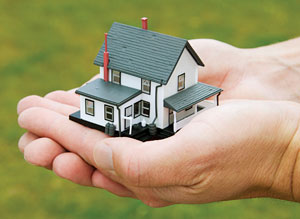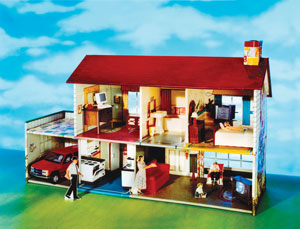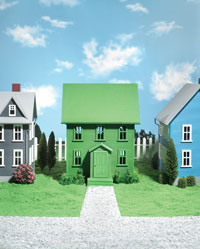Green Home, Sound Body
From March, 2009, EnergyTimes

Nurturing your own environment is the first
step toward helping the planet.
If a damaged environment evokes only images of
frightened polar bears floating on shrinking Arctic ice floes, consider
the more local impact. An array of toxic household products means that
it's too easy to damage the personal ecosystem housed within our own skin.
So if a closer look at product labels in your house turns up a list of
ingredients too difficult to pronounce, a green-home makeover may be in
order.
Too daunting a prospect? "Take a step that you can
do," suggests consumer advocate Debra Lynn Dadd, author of Home Safe Home
(Tarcher/ Penguin). "Change the sheets on your kids' beds or try buying a
bag of organic cookies. Just take one step, then another. You'll find that
you will feel better. If you look at it as something that is really going
to help your house in many ways, it becomes proactive, like taking
vitamins."
 |
Though "green" and "healthy" aren't always thought of as synonymous, they might as well be. What's bad for the environment often hurts our bodies, too. It's worth being vigilant. Of the 17,000 chemicals in common household products, only 3 in 10 have been tested for their effects on human health, says Beth Greer, a holistic health advocate who changed her lifestyle after being diagnosed with a benign chest tumor. |
As with cosmetics makers, manufacturers of
household cleaners are not required by the US Consumer Products Safety
Commission to test their products before they appear on store shelves,
observes Greer, author of Super Natural Home (Rodale), due out next month.
Nor does the Environmental Protection Agency require chemical
manufacturers to conduct human toxicity studies before approving their
products.
If attaining good health isn't strong enough reason
to ditch the chemicals, consider the economic cost of bad health. One
local study showed that the costs of lead poisoning, asthma, childhood
cancer and behavioral disorders such as autism and mental retardation
resulting from exposure to toxic chemicals and other pollutants totaled
$381 million just in the state of Maine.
Little wonder that green-home advocates remind
consumers to read product labels carefully—and with a healthy bit of
skepticism. "Natural," for example, is an undefined word that is
unregulated by government authorities. To help navigate this uncertainty
in your food and household product aisles, Dadd recommends shopping by the
process of elimination: Find labels that indicate a product's toxicity,
and avoid those items entirely.
Greer offers a couple of other litmus tests for
whether a household product belongs in your healthy home. A strong odor
and watery eyes are sure giveaways that what's inside that bottle belongs
nowhere near your body or in the air or water you consume. And if the
product you're using makes cleaning too easy, it's probably too harsh;
even with a cleaner, she says, you should have to scrub at least a bit.
 |
Instead of using harsh chemical cleaners, Greer suggests keeping three essential natural, non-toxic products on hand: hydrogen peroxide, vinegar and baking soda. They do as good a job as the more noxious stuff, but without making you sick. |
Greer cites tests at Virginia Polytechnic Institute
and State University in which cleaning with hydrogen peroxide and vinegar
in sequence purged heavily contaminated foods and surfaces of virtually
all salmonella, E. coli and shigella—even more effectively than commercial
cleaners or chlorine bleach. Many studies, she adds, have confirmed
vinegar as an effective disinfectant. In one study, a 5% solution of
vinegar killed 99% of bacteria, 82% of mold and 80% of viruses.
Dadd suggests creating household cleaners by mixing
a teaspoon of one or more of the following with one quart of warm or hot
water: trisodium phosphate (TSP) for heavy cleaning, liquid soap or borax,
with a little lemon juice or vinegar to cut grease. And one of the most
useful cleaners is the most accessible: boiling water.
These versatile and non-toxic cleaners can be used
in many rooms, including the bacteria-prone…
Kitchen
Countertops, appliances and wooden cutting boards
can be cleaned by spraying them with 3% hydrogen peroxide solution, Greer
says. It will kill the salmonella and other bacteria on the cutting board,
and the countertops and appliances will be disinfected. All that will be
left: a fresh, clean smell.
A powerful one-two punch, Greer says, involves
separate sprayings of hydrogen peroxide and either white or apple cider
vinegar. It doesn't matter which comes first; simply spray one immediately
after the other. Be sure to not mix the two.
You can also clean non-wood surfaces by spraying a
mix of one cup each of water and plain white vinegar, Greer says. Diluting
the vinegar is important because it can damage tile glaze.
Oven cleaners are among the more noxious cleaners.
The most risky toxins from these are lye and ammonia, says Dadd. (Even
oven cleaners that are pitched as having "no fumes" can be caustic, she
adds.) But instead of those noxious chemicals that you can immediately
feel attacking your nasal passages and beyond, Dadd says a friend of hers
mixes 2 tablespoons of liquid soap, 2 teaspoons of borax and warm water in
a spray bottle (make sure the soap and borax dissolve so you don't clog
the nozzle). Spray close to the oven, wearing gloves and glasses or
goggles. Wait 20 minutes, then scrub with steel wool and a non-chlorine
scoring powder. You can attack particularly stubborn areas with pumice. If
you must use a chemical cleaner (just once to attack years of layered
grime, Dadd says) don't use an aerosol.
Clean stainless steel pots and pans with baking soda to shine without scratching, Greer suggests. Stainless sinks can get the same treatment. A paste of baking soda and water can be left for a half hour on areas where food is sticking before sponging it off.
Though not necessarily a "green" issue, it's worth
being aware of a potential risk with granite countertops. Last year,
several news reports cited above-average levels of radon emissions from
some granite samples. Radon is an odorless radioactive gas that is the
second-leading cause of lung cancer, after smoking, according to the EPA.
While acknowledging that some granite used for
countertops may contribute to indoor radon levels, the EPA says data is
insufficient to conclude that such countertops are significantly
increasing indoor radon levels. The EPA says all homes should be tested to
ensure radon levels are below 4 picocuries per liter (pCi/L) of air. The
main concern should be radon emitted from the soil, but a professional can
also test your countertops. Inexpensive home radon test kits are also
available.
Your pantry and fridge should be stocked with
natural, organic foods. (See page 27 for a closer look at essential
organic produce.) But don't counteract the health benefits of locally
grown, organic foods by cooking them in aluminum or non-stick cookware or
serving them on ceramic dishes with leaded glazes, particularly those from
China, cautions Greer.
If you want to change some of your dishes start
with your mugs; hot liquid, Greer says, can leech the lead in them. And
when washing dishes, consider that most dish detergents are made from
petroleum, a nonrenewable synthetic source.
For a green, healthy kitchen, Greer recommends
avoiding what she calls the "fearsome five": pesticides; food additives
and artificial sweeteners and colors; factory-farmed foods; genetically
modified foods; and unfiltered tap water.
Bathroom
For sinks, tubs and showers, use baking soda as a
scouring powder. For tough stains, smear a paste of baking soda and water
on the spot and let it sit for a half hour before sponging. Again, Greer
recommends a 3% hydrogen peroxide solution to kill bacteria and viruses in
the shower.
Routine maintenance is key for a clean, non-toxic
shower, says Dadd. One way mildew grows in showers is via grout, which can
absorb oils from shampoos, conditioners and soaps. Dadd says wiping down
the tiles with a wet towel or rinsing them with the shower head after each
shower will minimize your cleaning time.
For cleaning the toilet, Greer recommends applying
plain, undiluted white vinegar.
And those bathroom towels? There are safe and natural solutions for
cleaning those, too. For starters, you may want to avoid using fabric
softeners. Fabric softeners often contain artificial fragrances that Dadd
says people with allergies should be wary of. Greer adds that fabric
softeners can make towels less absorbent. She recommends replacing your
fabric softener with a half-cup of vinegar added to the rinse cycle to
deodorize and soften them without losing absorbency.
Bedroom
In addition to your towels, reexamine how you clean your linens and the clothes in your bedroom closet or dresser.
As with many dish detergents, most conventional
laundry detergents are made from petrochemicals, a nonrenewable synthetic
source, and may contain bleaches, synthetic whiteners and artificial
fragrances that can make their way into our lakes and rivers as well as
our bodies.
Dadd recommends replacing such detergents with
natural soap flakes or grated bar soap. Soap-based laundry products are
available. But soap isn't always needed since laundering is often meant to
freshen clothing and remove perspiration and odors. In this case, a cup of
plain baking soda, white vinegar or borax will do. Or use a tablespoon of
trisodium phosphate, sold at hardware stores, per washer load.
Fabric softeners are used to combat static cling,
which is not an issue with natural fibers. So if you can't go cold turkey
with the fabric softeners, Dadd suggests that you try separating your
clothing by natural and synthetic fibers and use fabric softeners only
with the latter. For blended materials, Dadd says, experiment without
softeners. If you feel you must use one, Dadd says the safest fabric
softener is the unscented sheet that goes into the dryer.
Fabric softeners are one of those inventions of the
modern world, like synthetic fibers, Dadd observes. Health-wise, those
synthetic fibers are no great bargain, either. Cotton/polyester blend
permanent press fabrics, typically labeled "easy care" or "no iron," Greer
notes, have formaldehyde finishes that stick with even laundered material.
The best idea for any material you put next to your
body is organic cotton, grown without any chemical agents. Another option:
bamboo sheets, which Greer says are soft and affordable. For blankets, she
suggests trying untreated wool labeled "Pure Grow Wool" or "Eco Wool."
Wool is also naturally hypoallergenic and resists dust mites and mold.
Beneath your blanket and sheets is a more expensive
pursuit for living green, but one worth investigating: your mattress.
Annie B. Bond, author of Home Enlightenment: Create a Nurturing, Healthy,
and Toxin-Free Home (Rodale), calls mattresses "chemical wastebaskets"
that emit, or "out-gas," toxins from pesticides, herbicides, fire
retardants, stain-resistance solvents and formaldehyde, among others. Fire
retardant compounds called polybrominated diphenyl ethers (PBDEs) have
been linked to endocrine problems, Bond says, and may cause cancer.
If it's not affordable for the time being to replace your mattress with one made from wool, a natural fire retardant, or other non-toxic source, you have other options. A mattress topper or what Bond terms a barrier cloth encasement can help reduce exposure. Barrier cloth, Bond notes, is made from tightly woven threads that block fumes from passing through.
While we're in the bedroom, it might seem strange
to express concerns about invisible electromagnetic fields (EMFs) in the
place where you sleep, but that's precisely the point. Don't put your home
office in the bedroom; with an alarm clock, TV and other electronic
wiring, the place is already a potential hotbed for this unwanted
exposure. Elevated EMF levels can cause headaches, nightmares, depression,
fatigue and long-term illness, Greer observes.
For under $50, a Gauss meter can help you detect
high EMFs, which are measured in milligauss (mG). As a point of reference,
Bond says her dishwasher can measure more than 100 mG when running and 50
mG when off because it has an electrical transformer. In contrast, her
electric stove with two burners registered 1 mG at 2 feet. Even this low
level might cause ill effects, Bond says, citing studies conducted in
Sweden, so the last place you want excessive EMFs is the bedroom.
Avoid halogen lights or devices that have little
transformer boxes, Bond advises. Further, unplug lamps and appliances that
are near your bed before retiring. Talk to an electrician about a "demand
circuit" and other wiring tricks that can cut electricity flow when not
needed. A TV and electric clock, unless battery operated, Bond says,
should be kept at least 8 feet from the bed, through Greer is less
conservative and says the clock should be kept 2 to 3 feet from where you
sleep.
Home Office
To similarly block electrical fields, unplug your
computer when it is not in use. One technology trend in both computers and
television that is working in favor of good health, for both you and the
environment, is the move away from video display terminals (VDTs) and
toward liquid crystal display (LCD) screens. The transition is just about
complete in both computer and television manufacturing, so if you still
have an old VDT monitor, it won't be difficult to upgrade. LCDs, like
VDTs, produce radiation but it travels at shorter distances, Dadd notes.
Further, an LCD screen operates on less powerful voltage.
When your computer has reached the end of its life,
talk to your town or computer maker about how to recycle electronics.
and these...
To clean windows and mirrors, Greer recommends that you fill a bottle with equal parts vinegar and water, and spray. Don't worry about that initial vinegar smell—it disappears when it dries.
Particle board and plywood, often found in furniture like bookcases and desks, outgas formaldehyde, which irritates eyes, nose and throat and is a suspected carcinogen, says Dadd, who recommends buying natural furniture whenever possible. Dadd has bought used furniture and refurbished cushions with new cotton; she's also re-covered furniture with untreated cotton fabric.
Wall-to-wall carpets may do a lot to muffle sound pollution and make a house cozier, but the toxic tradeoff isn't worth it. Bond, who calls carpeting a "sinkhole" of allergens and toxins, cites risks from glues that attach carpet to flooring, pesticides from latex binders and volatile organic compounds (VOCs) "from a chemical soup of dozens and dozens of chemicals used in carpet manufacturing." Go with hardwood flooring.
Trade in the SUV.
...Or convert it to hydrogen!!
This article originally published at: http://www.energytimes.com/et2/pages/features/greenhome.html